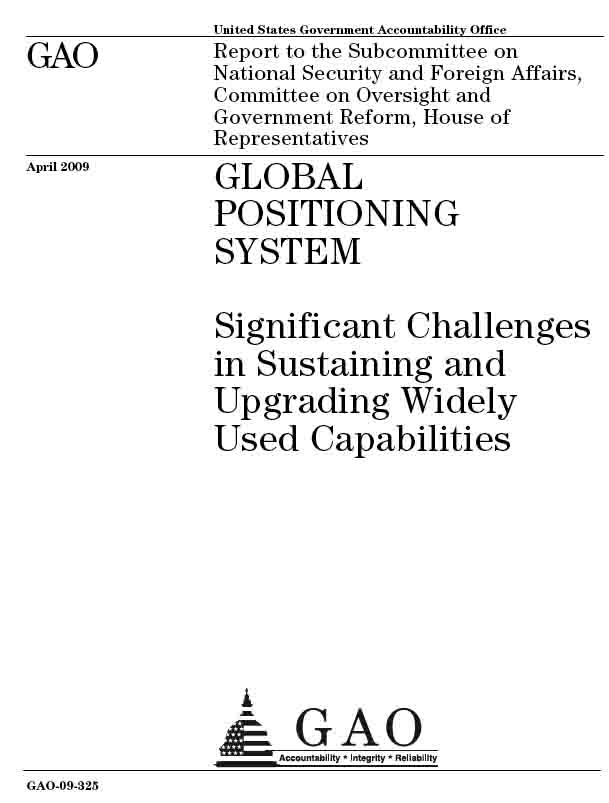
As if a puzzling signal anomaly on the latest GPS Block IIR-M satellite and continued struggles in the long-delayed Block IIF schedule hadn’t created enough pressure, a recent U.S. Government Accountability Office (GAO) report sketches dire prospects for the GPS program.
As if a puzzling signal anomaly on the latest GPS Block IIR-M satellite and continued struggles in the long-delayed Block IIF schedule hadn’t created enough pressure, a recent U.S. Government Accountability Office (GAO) report sketches dire prospects for the GPS program.
In what is not necessarily its worst-case scenario, for example, the GAO suggests that a two-year delay in the production and launch of the first and all subsequent GPS III satellites “would reduce the probability of maintaining a 24-satellite constellation to about 10 percent by around fiscal year 2018.”
That would be fewer than the minimum number of satellites to which the U.S. government has committed for national and international user communities. It would also surely diminish the quality of GPS service, particularly for military, safety-critical, and urban applications.
However, 12 months into a 72-month schedule from contract award to first launch, the GPS IIIA program is still on track for a 2014 launch, according to officials at the GPS Wing and Lockheed Martin, which won the $1.4-billion development and production contract in May 2008.
The GPS Wing, part of the Space & Missile Systems Center (SMC) at Los Angeles Air Force Base, California, successfully completed an integrated baseline review of the GPS IIIA program last October 31. An overall segment-level preliminary design review (PDR) will take place within about a week.
In March, Lockheed Martin Space Systems said the company and industry partners ITT and General Dynamics had successfully completed 19 out of 71 PDRs for key GPS III spacecraft subsystems and assemblies. These included L-band transmitters, antennas, solar arrays, power regulation unit, all attitude control assemblies, as well as the tracking telemetry and command (TT&C) subsystem and all TT&C assemblies.
The U.S. government plans to invest more than $5.8 billion from 2009 through 2013 in GPS Space and ground control segments. The proposed 2010 fiscal year (FY10) budget for the GPS program expenditures on these items is $927.8 million. This will fund satellite launch, integration of replenishment satellites, and continued development of the GPS constellation, including GPS III, as well as the ground control system (OCX).
Nonetheless, in a report issued April 30 under the title, “Global Positioning System — Significant Challenges in Sustaining and Upgrading Widely Used Capabilities,” Cristina Chaplain, the GAO’s director of acquisition and sourcing management and primary author of the report, indicated that “considerable risk” still exists that the schedule may not be met.
Noting GPS IIIA’s “highly compressed” timeline, the GAO report said that the schedule “is shorter than most other major space programs we have reviewed,” adding “no major satellite program undertaken in the past decade has met its scheduled goals.”
A 2-year delay in the launch schedule would translate into “5 years when the U.S. government would be operating a GPS constellation of fewer than 24 satellites, and a 12-year period during which the government would not meet its commitment to maintaining a constellation of 24 operational GPS satellites with a probability of 95 percent or better.”
Moreover, the GPS IIIA design, which would deliver a new GPS civil signal at L1, will require substantial enhancements to existing satellite capabilities, including a 10-time increase in military signal power and a larger bus to accommodate future GPS increments IIIB and IIIC.
Even before the 2014 first GPS IIIA launch, however, the GAO warns that a 20 percent chance will arise in 2011-2012 that the constellation could drop below 24 space vehicles (SVs) as older satellites begin failing faster than they can be replaced.
Based on an 18-month investigation by the GAO, the report’s conclusions merely confirm what has been a growing awareness within the U.S. Air Force and the GPS community that continuing delays in modernization efforts are hobbling the program. Indeed, a 2005 Defense Science Board Task Force identified many of these problems, predicted the risks now seeming even more likely to occur, and made similar recommendations.
Congressional Interest
The study was requested by the national security and foreign affairs subcommittee of the U.S. House of Representatives Committee on Oversight and Government, which held a hearing May 7 on the topic, “GPS: Can We Avoid a Gap in Service?” Chaplain, Air Force, Department of Defense (DoD), and industry representatives provided testimony at the hearing.
In his opening statement at the hearing, subcommittee chairman John Tierney (D-Massachusetts) said, “The reality is that from an acquisition perspective, we are nearing the eleventh hour. The President’s fiscal 2010 budget terminates funding for the primary GPS back-up system, LORAN. That puts a lot of pressure on DOD to ensure GPS meets all user needs—a precarious position to be in if a gap is looming.”
“GPS is a critical asset to our economy and to our security,” Tierney added. “It’s unfortunate that we may find ourselves in a position of weakness because we have not yet learned to get our procurement house in order.”
In a presentation to the subcommittee, Maj. Gen. Neil McCasland, U.S. Air Force director of space acquisition, said that the problems with the Block IIF — which have more than doubled the program cost to $1.6 billion from $729 million — have “propelled the Air Force to launch a campaign to rebuild our confidence in the schedule of this critical space system through a renewed focus on mission assurance.”
“A key element of our strategy is to deliver the first GPS III satellite to a known schedule,” McCasland said. “We worked hard with our requirements arm, our industrial partners, and our fiscal planners to ensure we integrated every lesson from the past to create a high-confidence GPS III schedule.”
More Problems than Just the Satellites
Aside from possible launch delays and constellation decline, the GAO report criticized the failure of the GPS program to “synchronize” the acquisition and development of the next generation of GPS satellites with the corresponding timelines of the ground control segment and military user equipment. The result: a likelihood that the modernized military signal (M-code) will be available for more than a decade “before user equipment will be fielded that can take strategic advantage of it.”
The report attributed the problems to a variety of causes: a bungled acquisition reform introduced in the 1990s (Total System Performance Responsibility), turnover in military program leadership, diffuse responsibilities for GPS system development within the DoD, reprogramming of GPS funds to other DoD program (or from GPS control segment and user equipment programs to backfill cost overruns in the space segment), fielding of immature technologies, post-contract engineering changes (“mission creep”), and so on.
Acknowledging Air Force and DoD efforts in recent years to improve the situation, the GAO recommended that the secretary of defense “appoint a single authority to oversee the development of the GPS system, including DoD space, ground control, and user equipment assets, to ensure that the program is well executed and resourced and that potential disruptions are minimized.”
According to the GAO, that the appointee “should have authority to ensure DoD space, ground control, and user equipment are synchronized to the maximum extent practicable; and coordinate with the existing positioning, navigation, and timing [PNT] infrastructure to assess and minimize potential service disruptions should the satellite constellation decrease in size for an extended period of time.”
In a presentation to the House subcommittee hearing, a DoD official said that “Deputy Secretary of Defense [William] Lynn has “reaffirmed” that the assistant secretary of defense for networks and information integration — ASD(NII) — “is designated with authority and responsibility for all aspects” of the Global Positioning System.
Until recently, the ASD(NII) — as well as the DoD’s chief information officer — was John Grimes, a holdover from the Bush administration. President Obama has not yet named a replacement, who must be confirmed by the U.S. Senate.
In a response to the GAO recommendations, DoD’s officials noted that “under oversight of the ASD(NII),” the U.S. Air Force is the single acquisition agent with responsibility for synchronized modernization of GPS space, ground control, and military user equipment.
Because that position essentially restates the current status, including a 2008 revised DoD directive (4650.05) on PNT, further efforts would appear needed to increase the leverage that ASD(NII) has over the program.
On May 8 Secretary of the Air Force Michael Donley and Air Force Chief of Staff Gen. Norton Schwartz announced their plan for improving the service’s acquisition efforts. The plan outlines five initiatives with 33 actions that are intended to “ensure rigor, reliability and transparency across the Air Force acquisition enterprise.” Among those actions are an increase in the size and improvement in the training and experience of the Air Force’s professional acquisition corps, which has been cut by 41 percent over the past 20 years.





